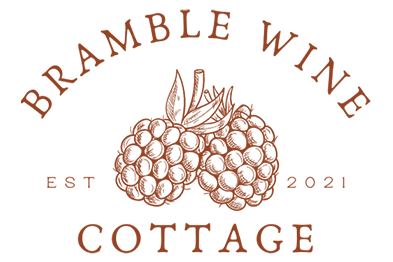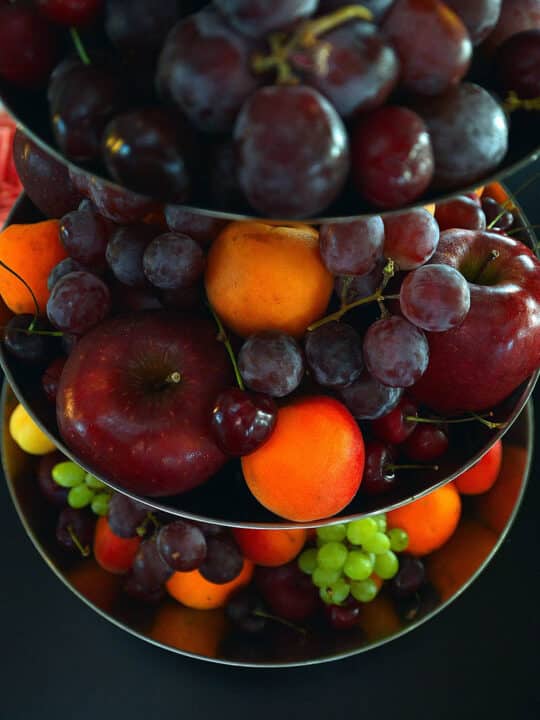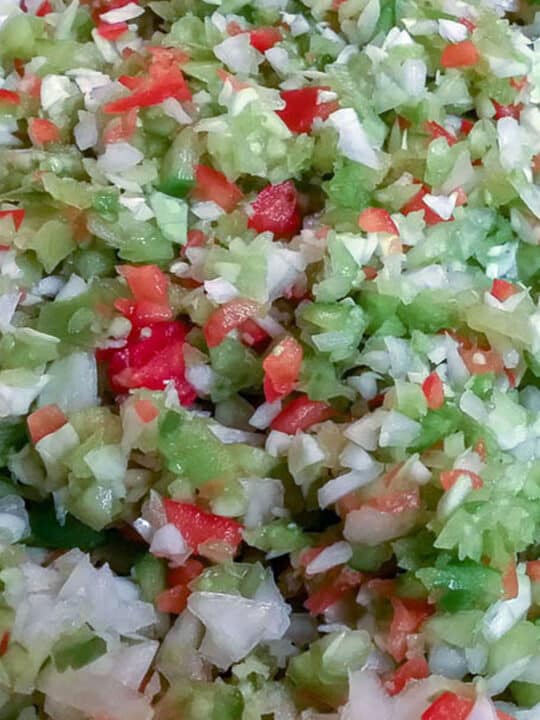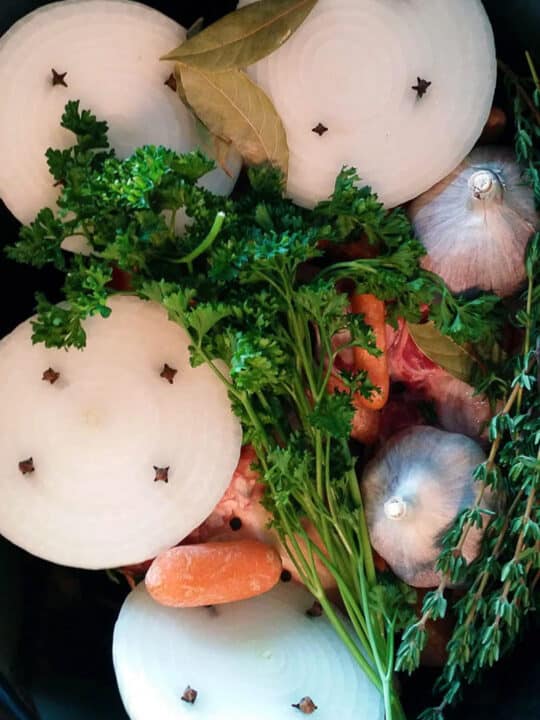Canning potatoes to add to your food storage gives you a really versatile ingredient you can use for any meal in dozens of ways.
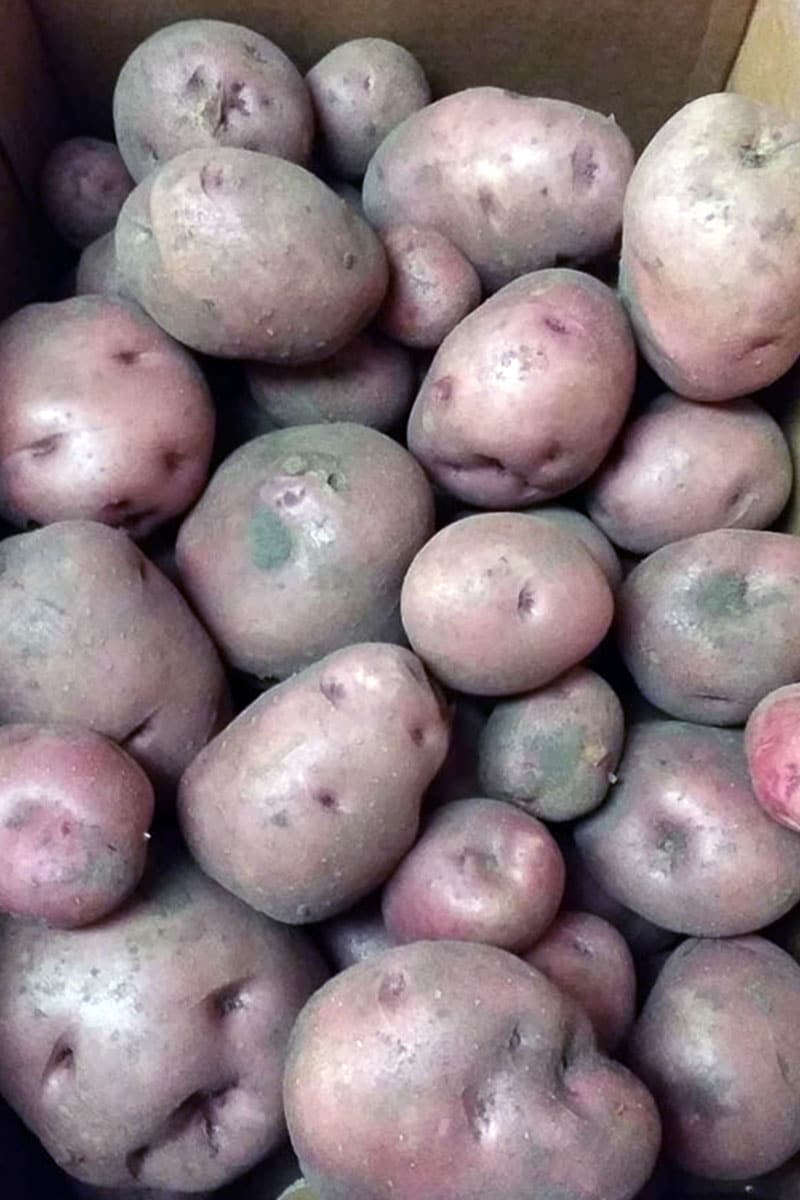
How many pounds of potatoes does your family go through in a year? Probably more than you think!
And while baked potatoes are my hands down favorite way to eat them, there’s not too many ways you can fix a spud that I don’t like.
Potatoes are a staple in my menu plans. And because they are a part of many meals, they are a large part of my canning pantry and long term food storage.
And guess what?
Canning potatoes gives you a great quick fix item from your pantry.
You can use canned potatoes so many ways! Try adding them to soups, stews, and casseroles.
And don’t forget about mashed potatoes!
Which is my second favorite way to eat spuds.
You could also heat them up, drain them, and then add butter and parsley. Delicious!
Or pour a cheese sauce over them.
Hundreds of ways to use these guys!
So grab some taters and let’s learn how to can potatoes!
Need more easy canning recipes? Grab a copy of my eBook “The Basics of Pressure Canning” and start filling your pantry today!

Canning Potatoes
NOTE: The National Center for Home Food Preservation currently recommends peeling and par-boiling potatoes before canning. This is a tested recipe that is older and does not require that. I have used this recipe for 40 years without issue.
Yield: 2-½ to 3 pounds (7 to 9 medium potatoes) = 1 quart; 1 bushel (50 pounds) = 20 quarts
- 17½ to 21 pounds of potatoes for a canner load of 7 quarts
- large bowl of water
- sea salt
- wide mouth quart canning jars
- new lids
- rings/bands
- pressure canner
- jar lifter
- lid lifter
- bubble popper
- old towels
- a couple of large pots for par-boiling (optional)
NOTE: I’m using Yukon Gold potatoes in these pictures. Which, incidentally, make the best Loaded Baked Potato Soup! I also do russets and red potatoes.
But you can pressure can any kind of potato that you want using these same instructions. Different types of potatoes have different amounts of starch and will give you slightly different textures.
So think about what you will use the potatoes for. Do you want to mash them? Add them to soups or stews? Just heat with butter and parsley?
Some people don’t like the texture of raw packed potatoes. You can par-boil your potatoes before canning if you wish. This will also get rid of some of the starch that ends up making the jars look less than beautiful.
Prepare your jars and lids and keep them hot until needed. Check the air vent and overlock on the canner lid to make sure they are not blocked.
Prepping the potatoes for canning
Put 2 quarts of cool water in a large bowl and stir in 2 teaspoons of sea salt. Stir it up until it dissolves. This will keep the potatoes from turning brown as you cut them and it will also pull out some of the starch.
Scrub your spuds with a stiff brush under running cold water. You can peel potatoes or leave the peel on.
I do some of both depending on how much time I have. Give them another rinse after you peel them if they need it.
One downside to leaving the peel on is that is tends to come off in the jar and make a mess. But I never peal the red-skinned potatoes. because that doesn’t seem to be a problem with those. Maybe because they have thin skins?
If you have small potatoes that are 1 to 1½ inches in diameter you can leave those whole.
Larger potatoes need to be cut into ½ to 1 inch cubes. As you cut them, put them into the salt water.
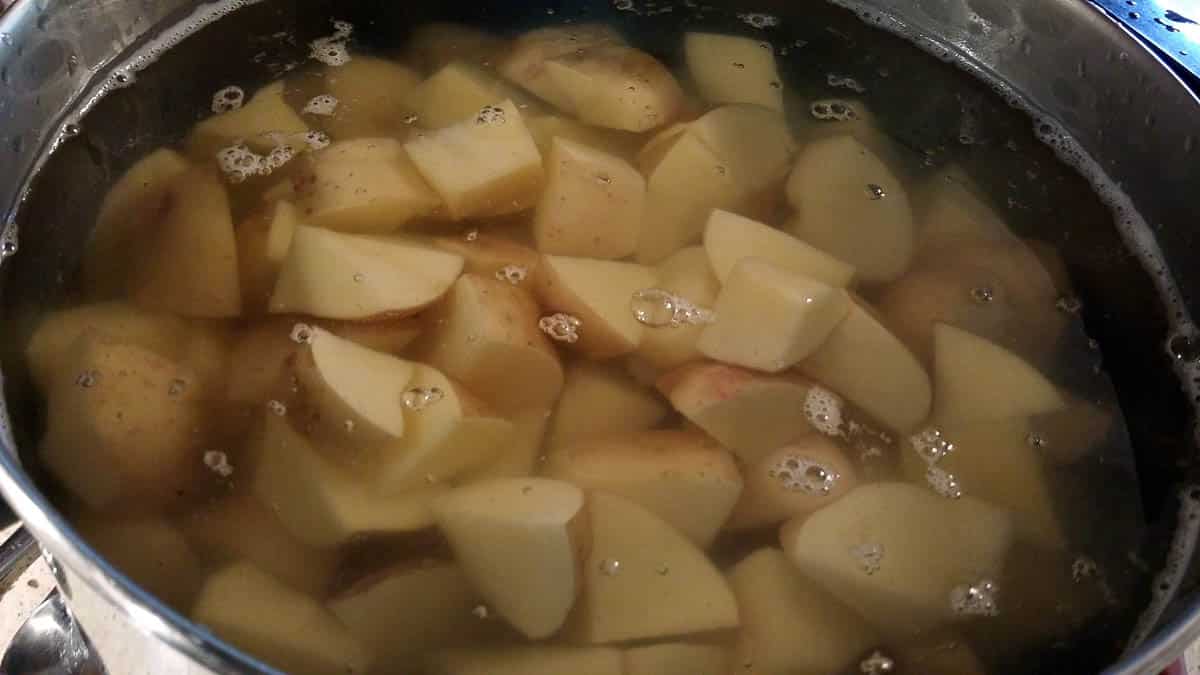
If you have time, leave them in the water for 20 to 30 minutes, changing out the water about half way through. This not only keeps them from turning brown, but it removes some of the starch which makes the water in the jar cloudy.
After the potatoes have soaked in the salt water, get the kettle going. If you are parboiling your potatoes, keep them warm until you are ready to put them in the jars.
To parboil potatoes, cook the cubes in boiling water for 2 minutes. For small whole potatoes, cook for 10 minutes in boiling water.
Drain the potatoes in a colander.
Using a canning funnel, pack the raw or hot potatoes into the hot jars, leaving 1-inch headspace.
Add salt, if desired, using ½ teaspoon in pints, ¾ teaspoon in 1½ pints and 1 teaspoon in quarts.
Now add the boiling hot water leaving 1 inch of headspace.

Using a bubble popper or thin knife, run it around the inside of the jar to release any trapped air bubbles. Top off with boiling water if needed.
Wipe the rim of the jar with a clean dry cloth or paper towel to make sure it’s clean.
With your lid lifter, pull out the lids and put them on the jars. Screw the rings on finger tight.
Now take that water the lids and rings were in and pour that into the canner, adding a splash of white vinegar if you have hard water.
Processing Potatoes
Ok. Now that the lids are on, it’s time to put the jars into the canner.
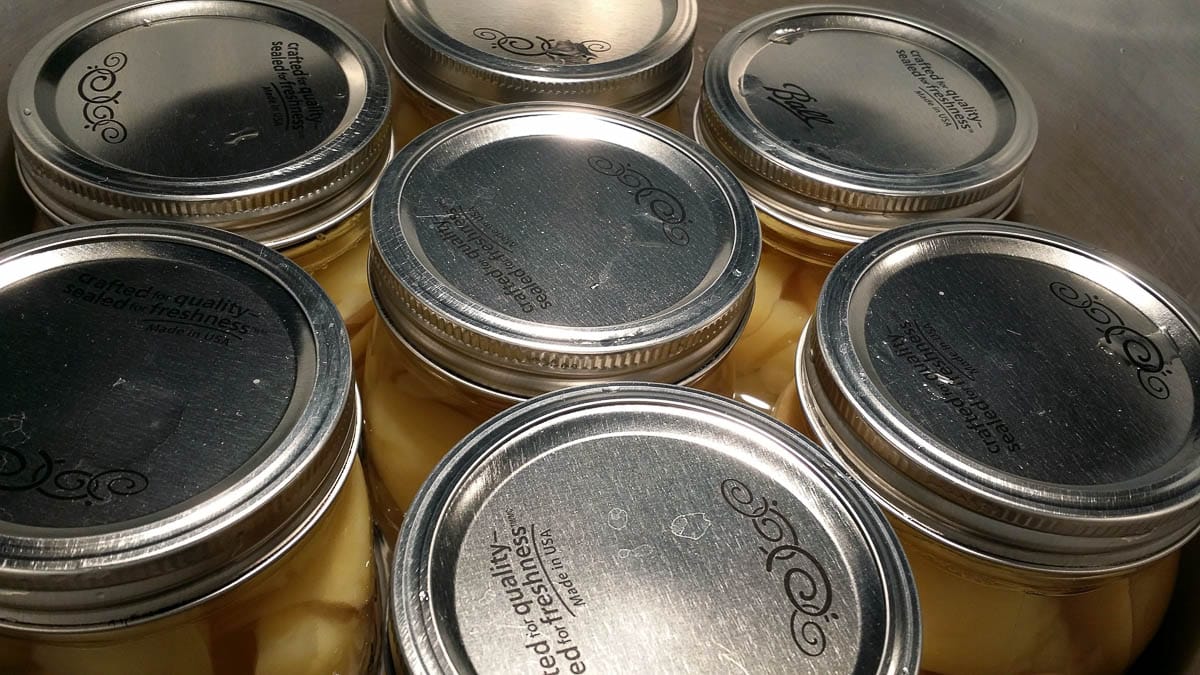
Put the lid on and seal it and turn the heat to high.
Allow the canner to vent for the specified length of time for your canner.
Now put the regulator on the air vent and bring it up to pressure.
Once it has reached the required pressure, start your timer.
Process pints at 10 pounds of pressure for 35 minutes, process 1½ pints and quarts at 10 pounds of pressure for 40 minutes.
Don’t forget to adjust the processing pressure for your altitude using this chart.
When the processing time is up, turn off the heat and allow the pressure to return to zero.
Once the pressure is zero, remove the regulator and wait another 5 to 10 minutes before unsealing the lid.
Make sure the lid is facing away from you when you open the canner.
After processing, remove the jars from the canner and allow to sit undisturbed for a minimum of 12 hours.
After 12 hours, you can check the seals, wash and label the jars, and put them away.
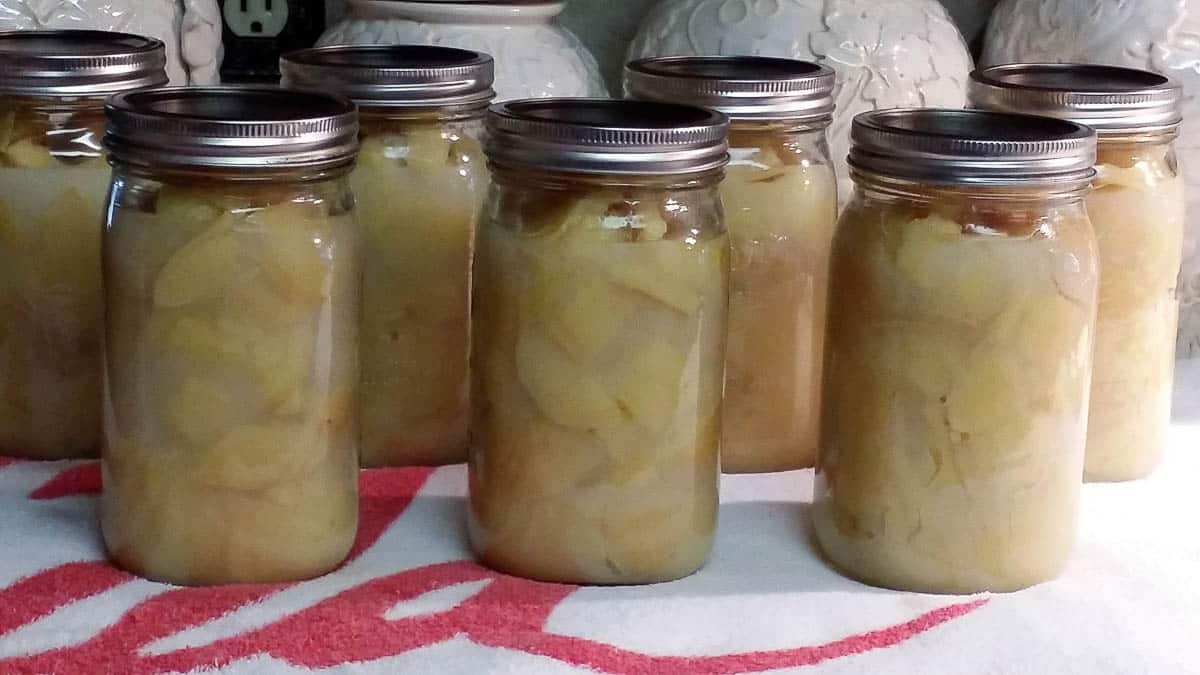
Canning potatoes at home gives you a lot of bang for your buck!
Especially if you grow your own.
But you can also save big by stocking up when potatoes are on sale in November and December.
Stored properly, canned potatoes will last a minimum of 2 years.
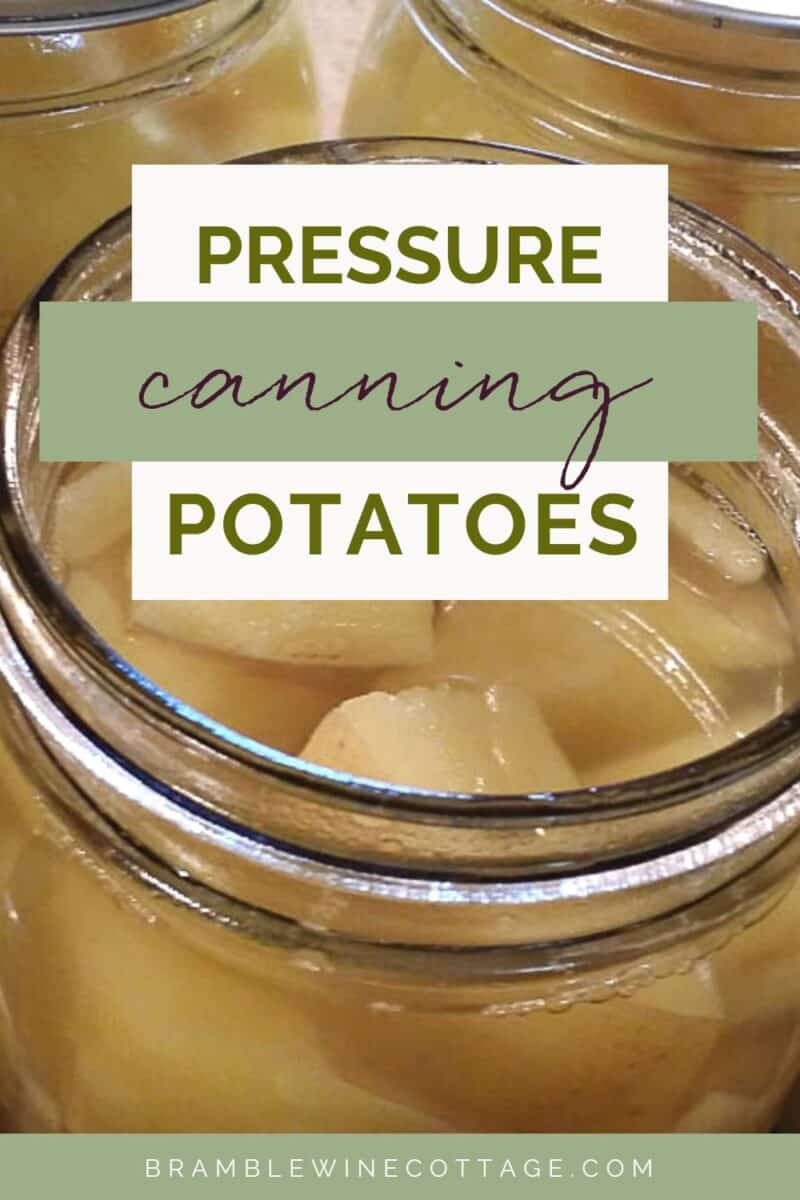
Frequently Asked Questions About Canning Potatoes
It depends on what you are going to use them for. People will tell you not to can Yukon Golds, but those are some of your favorites that make the best mashed potatoes. I say, can what you have. They all turn out good.
Properly sealed and stored, canned potatoes will last for several years. It’s recommended that you eat them within 2 years for the best texture and nutritional value.
I add them to soups and stews right out of the jar.
If I want to mash them, I will rinse them first, then heat in water on med low. Add butter, milk, salt & pepper, and maybe some cheese and sour cream.
For parslied potatoes, rinse and reheat in water. Drain and add butter and parsley flakes.
More canning recipes you should try:
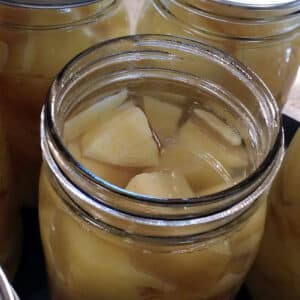
Pressure Canning Potatoes
Equipment
- Pressure Canner
- wide mouth quart canning jars
- New lids
- rings/bands
- Canning Tools
- old towels
- large pot for par-boiling optional
Ingredients
- 17½ to 21 pounds of potatoes for a canner load of 7 quarts
- large bowl of water
- sea salt
Instructions
- Prepare your jars and lids and keep them hot until needed. Check the air vent and overlock on the canner lid to make sure they are not blocked.
- Put 2 quarts of cool water in a large bowl and stir in 2 teaspoons of sea salt. Stir it up until it dissolves.
- Scrub potatoes with a stiff brush under running cold water. Peel them or leave the peel on.
- If you have small potatoes that are 1 to 1½ inches in diameter you can leave those whole. Larger potatoes need to be cut into ½ to 1 inch cubes. As you cut them, put them into the salt water.
- Par-boil potatoes (optional): cook cubes in boiling water for 2 minutes, cook small whole potatoes in boiling water for 10 minutes.
- Drain the potatoes and loosely pack the potatoes into the hot jars, leaving 1 inch headspace.
- Add salt, if desired, using ½ teaspoon in pints, ¾ teaspoon in 1½ pints and 1 teaspoon in quarts.
- Add boiling water leaving 1 inch of headspace, releasing trapped air.
- Wipe the rim of the jar with a clean dry cloth or paper towel and add lids and rings, tightening finger tight.
- Add water to the canner, adding a splash of white vinegar if you have hard water. Put the jars in the canner.
- Seal the lid and turn the heat to high.
- Allow the canner to vent for the specified length of time for your canner.
- Put the regulator on the air vent and bring it up to pressure.
- Once it has reached the required pressure, start your timer.
- Process pints at 10 pounds pressure for 35 minutes, process 1½ pints and quarts at 10 pounds pressure for 40 minutes. Don’t forget to adjust the processing pressure for your altitude.
- When the processing time is up, turn off the heat and allow the pressure to return to zero.
- Once the pressure is zero, remove the regulator and wait another 5 to 10 minutes before unsealing the lid.
- Remove the jars from the canner and allow to sit undisturbed for a minimum of 12 hours.
- After 12 hours, check the seals, wash and label the jars, and put them away.
